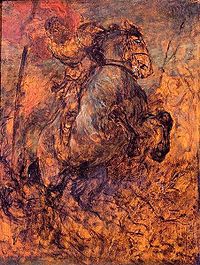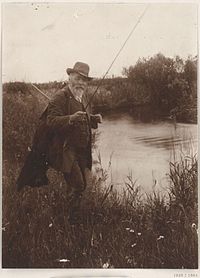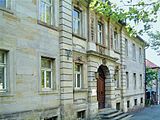Wilhelm von Diez
Albrecht Christoph Wilhelm von Diez (born January 17, 1839 in Bayreuth , † February 25, 1907 in Munich ) was a German painter and illustrator of the Munich School .
Life

Diez attended the trade school in Bayreuth, the polytechnic school in Munich from 1853 to 1855, and the Munich Art Academy in 1855 , where he was a student of Karl Theodor von Piloty for four weeks . However, he left the academy after a short time again and formed a self-taught as an artist and painter on.
Diez first became known through numerous works in the Fliegende Blätter and the Münchener Bilderbogen . In 1871 he illustrated Schiller's story of the Thirty Years' War . His drawings are characterized by a light line in the manner of etchings and an open, clear treatment of the shadow. He later also emerged through genre painting , animal pictures and landscape painting .
In January 1871 Diez became a teacher at the Munich Art Academy, headed by Wilhelm von Kaulbach , and soon afterwards a professor there. In this position he exerted a decisive influence not only on numerous students (including Franz Marc , Max Slevogt , Wilhelm Trübner , Ludwig von Löfftz , Heinrich Lefler , Joseph Henfling , Hans Gyenis , Franz Xaver Dietrich , Alfred Juergens and Fritz Mackensen ), but also on the development of the whole Munich school in the direction of colorism . Diez was not about to paint a single scene because their outer appearance, as in the Munich school until then prevailing historical painting did; rather, he presented a piece of cultural history to the viewer even in his smallest pictures.
At the Munich International Exhibition of 1883 he was awarded the "Great Gold Medal" for the Adoration of the Shepherds .
Works
- Forest Festival ( Rococo Period ), National Gallery Berlin
- Dead deer , National Gallery Berlin
- Saint George the Dragon Slayer (study), National Gallery Berlin
literature
- Hermann Uhde-Bernays : Diez, Wilhelm von. In: New German Biography (NDB). Volume 3, Duncker & Humblot, Berlin 1957, ISBN 3-428-00184-2 , p. 711 f. ( Digitized version ).
- Stefanie Kamm: Wilhelm von Diez. 1839-1907. An artist between historicism and art nouveau . (= tuduv studies; series art history; volume 43). tuduv, Munich 1991, ISBN 3-88073-390-2 (art history dissertation with catalog raisonné)
Web links
- Literature by and about Wilhelm von Diez in the catalog of the German National Library
- Wilhelm von Diez in HeidICON - pictures in the "Flying Leaves"
- Wilhelm von Diez and his 74 students In: Academy of Fine Arts Munich
gallery
| personal data | |
|---|---|
| SURNAME | Diez, Wilhelm von |
| ALTERNATIVE NAMES | Diez, Albrecht Christoph Wilhelm von (full name) |
| BRIEF DESCRIPTION | German painter and illustrator |
| DATE OF BIRTH | January 17, 1839 |
| PLACE OF BIRTH | Bayreuth |
| DATE OF DEATH | February 25, 1907 |
| Place of death | Munich |


